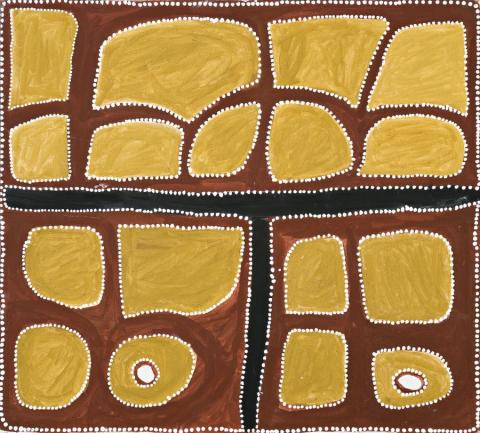FIG TREE HOLE, 1998
PADDY BEDFORD
natural earth pigments on linen
122.0 x 135.0 cm
signed verso, together with date, title and Jirrawun Aboriginal Art Corporation catalogue number P.B. 98. 25
Jirrawun Aboriginal Art Corporation, Kununurra
Martin Browne Fine Art, Sydney (inscribed verso)
Private collection, Sydney
Storer, R., (Curator), Paddy Bedford, Museum of Contemporary Art, Sydney, 2006 p. 144 (illus.)
Bedford is a Gija man of the Jawalyi skin, born at Bedford Downs Station in the East Kimberley region of Western Australia.
Catalogued as painting 25 in Bedford's chronological index of works, this painting dates from 1998, the first year of the artist's painting career. Depicting the country of Fig Tree Hole, Jamelayigoon, located to north of Lightning Creek Lerdijwaneman, the site is characterised by a river running between high cliffs and a large cave on the rock face. This is the dreaming place of rock wallaby, woonyjoorroony, and along the river are waterholes that are the dreaming place of the red rivergum, birlinji.
The area is associated with Bedford's father who was born close by at Wirndoowoon. Bedford's personal dreaming minjiwarrany (black plum) was inherited from his father and is also linked with this place.
Stylistically, Fig Tree Hole extends the manner and sparseness that characterised the east Kimberley school. His use of ochre colours and bold abstract forms contained in a defined structure and articulated by an outline of minimal dotting is similar to the work of Rover Thomas and Freddie Timms. At this early stage of his work, the gold ochres of his palette predominate over brown and black. In later works, his palette broadened to incorporate softer, more delicate hues, and further changed to explore more intense colours of yellows, reds, blues and pinks.
In 2006 Paddy Bedford was honoured with a major retrospective at the Museum of Contemporary Art, Sydney, and he was also one of eight Aboriginal artists commissioned to produce a major work for the new Musée du quai Branly in Paris.
